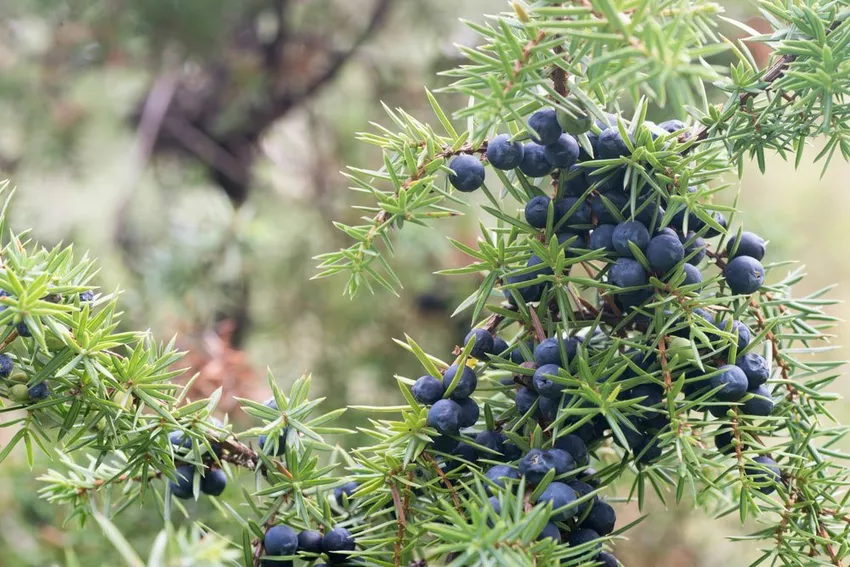Who wants to propagate juniper. You will find three options with corresponding instructions here. But this project will not be an easy task.

The juniper (Juniperus) belongs to the cypress family and brings Mediterranean charm to our gardens. The plants are also known as fire trees or incense shrubs and come in various species with different growth forms and colors. Anyone who does not own a juniper in the garden and wants to propagate by cuttings may have problems in the wild. The common juniper has been under nature protection since the 1930s. It is allowed to pick the berries. However, cutting branches to obtain cuttings is prohibited.
The propagation of plants can happen in different ways:
1. Cuttings2. seeds3.Offshoot❶ Propagating juniper by cuttings
Young but already woody shoots are required for propagation by cuttings. These can be cut preferably in late summer. The end of the main shoot is cut off about five millimeters below an auxiliary shoot. The secondary drive is then torn off abruptly. A so-called "bark tongue" forms. The cutting is shortened to a length of about 15 centimeters. Then free the cutting from the needles in its lower third and cut off the tip of the shoot. The lower end of the cutting is scored with a knife.
➞ Tip: If the interface with "Bark Tongue" is treated with Algan, Neudofix or another rooting agent, the cutting will grow faster.
The cutting needs loose and sandy soil. The cuttings are now rooted in a bright location with temperatures around 20 degrees. If the planter is provided with a plastic hood, the rooting can also be promoted. The soil should be kept regularly moist, but too much moisture should be avoided. By spring the cuttings should have rooted enough to be transplanted. Plant out in the desired spot outdoors after about two to three years.
Juniper propagation by cuttings in keywords
- young shoots should be lignified
- Length up to 20 centimeters
- Place cuttings in sandy substrate
- set warm and bright
- keep evenly moist
- plant out after two to three years
❷ Propagating juniper by seeds
Propagation by seeds is quite difficult for the inexperienced hobby gardener, but at the same time represents a challenge. The berries of the juniper appear green at first and are not yet suitable for seed production at this stage. Another two years pass before the berries turn blue-black and can therefore be harvested in late summer to autumn. It is a good idea to dry the berries for a few months before collecting the seeds.
In order to make the dried seeds more germinable, they are first watered for several days. The berries are then crushed, the seeds picked out and washed in a sieve. Germination also promotes brewing with about 60 degree hot water. After a brewing time of about two hours, the seeds are cooled and stored in a plastic bag in the refrigerator for about three months. Then it can finally be seeded.
The germination temperature should be 15 to 20 degrees. The best time for sowing is autumn. The plant pot is filled with compost. The seeds are covered with sand. The seeds should be kept evenly moist. After germination, the young plants are allowed to move to a planter filled with soil and sand.
➞ Tip: Collect plenty of seeds, because the germination rate is exceptionally low, despite the complex procedure just described.
Juniper propagation by seeds in keywords
- Harvest berries
- dry about three months
- Mash Berries
- Read seeds
- Scald Seeds
- Keep seeds in the refrigerator for three months
- Sowing in Spring
❸ Propagating juniper by offshoots
Propagation by offshoots seems far less problematic. Some juniper species, such as the creeping juniper, produce plenty of offshoots. After the offshoots have formed sufficient roots, they can be separated from the mother plant and planted separately. This makes propagation by cuttings by far the simplest form.
Propagating junipers: options with advantages and disadvantages
| Propagation method | Advantages | Cons |
| Cuttings | » Propagation by cuttings is a very simple method of obtaining new juniper plants. » The probability of rooting is high. » This gives the hobby gardener a good chance of success. | » In order to take cuttings, a plant must already exist. » It takes several years before the young plants can be planted outdoors. |
| Seeds | » The soil should be loose and slightly acidic. » A mix of potting soil and clay granules is well suited. » Cactus soil can also be used. | » The method is extremely complex and time-consuming. » The hobby gardener needs a lot of patience, and the chances of success are comparatively low. |
| Offshoot | » It is important to choose a sufficiently large planter that is not too light. > » A drainage in the bottom of the planter protects against waterlogging. » The roots are closed when planting Gentle. » The plants are well watered. » The irrigation water should be able to run off immediately. | » A mother plant must be present to produce offshoots. » This method has limitations, not all juniper species produce offshoots. |
Care for young juniper plants
A sunny location is important for the young juniper plants. The offshoots and cuttings are less demanding in terms of the substrate. If the substrate is enriched with peat, the young plant gets the necessary nutrients immediately when planting. If a hedge is to be planted, two plants must be planted per meter. Juniper grows comparatively slowly.
Tip: Young plants need a lot of nitrogen. Fertilizer can be given until June.
Juniper tolerates drought better than waterlogging. Young plants in particular should be kept regularly moist.